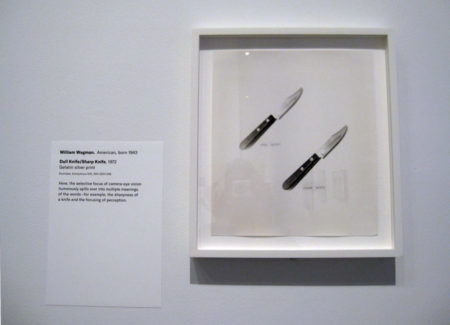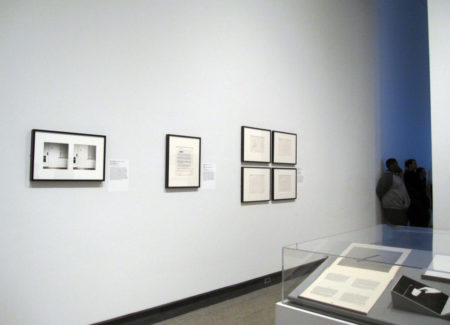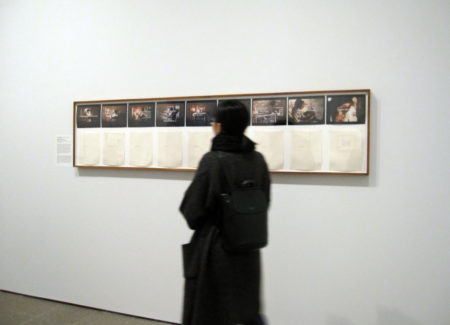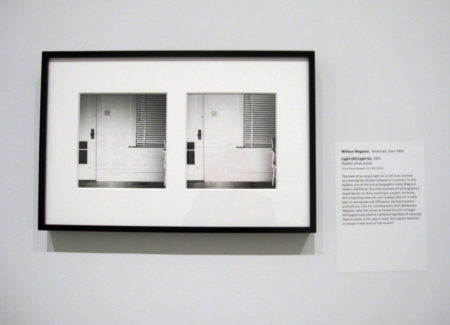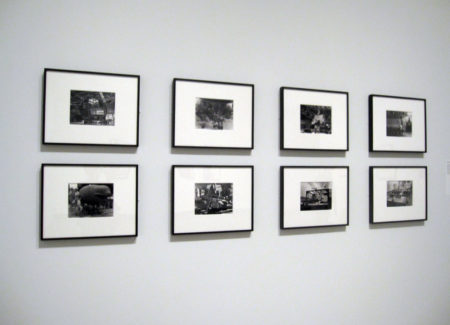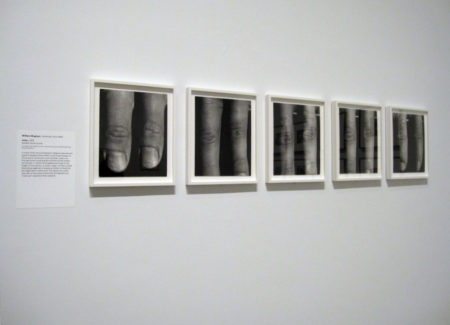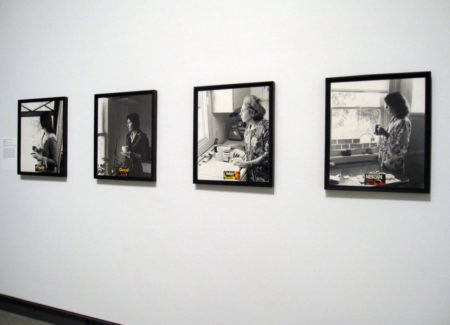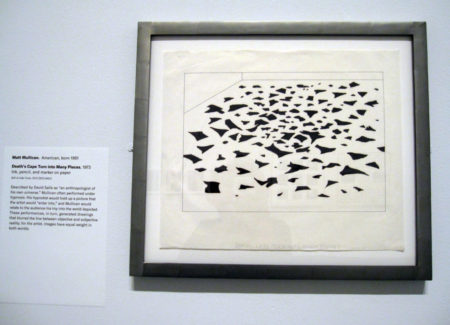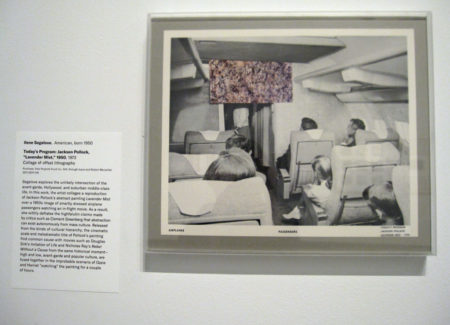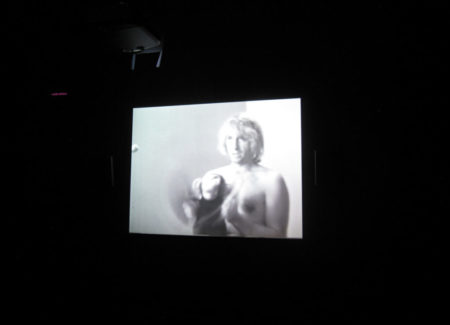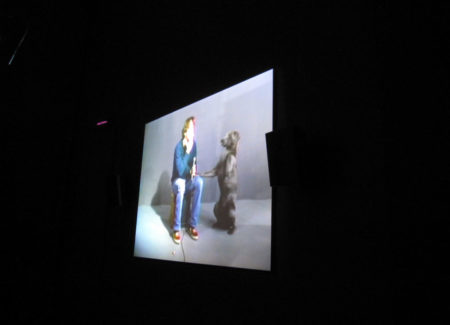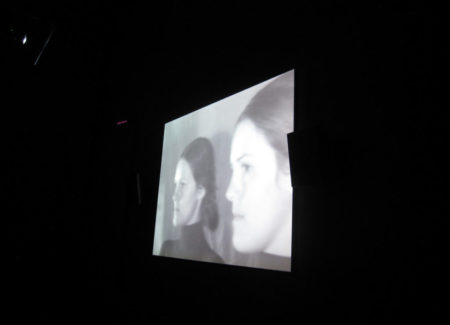JTF (just the facts): A total of 123 works—92 by William Wegman and 31 by other artists—exhibited against white walls in a large single-room gallery space on the museum’s second floor. All of the works date from between 1967–1977, and beyond those by Wegman, the show includes photographs/artworks by the following:
- John Baldessari
- Vija Celmins
- Robert Cumming
- Douglas Huebler
- Matt Mullican
- Bruce Nauman
- Allen Ruppersberg
- Edward Ruscha
- David Salle
- Ilene Segalove
The works on view include:
- 73 black-and-white single-channel digital videos with sound, transferred from 1/2-inch video tape, running times between 15 sec. and 4 min., 43 sec.
- 7 color single-channel digital videos with sound, transferred from 3/4-inch video tape, running times between 12 sec. and 1 min., 47 sec.
- 14 works comprising one or more gelatin silver prints
- 1 work comprising four gelatin silver prints with affixed color advertisements
- 1 ink, pencil, and marker drawing on paper
- 1 work comprising gelatin silver prints and typescript
- 1 work comprising chromogenic prints and typescript
- 1 typewritten text with graphite on paper
- 1 gunpowder drawing on paper
- 1 collage of offset lithographs
- 2 lithographs
- 6 graphite drawings on paper
- 14 artist’s books
- Plus a set of promotional materials for “Al’s Grand Hotel” (1971), including brochure, prospectus, and business envelope
(Installation shots below.)
Comments/Context: William Wegman’s anthropomorphizing photographs of dogs, starring several generations of pale eyed, silvery-gray Weimaraners, have brought him popular acclaim, as well as a string of publishing, television, and advertising deals. But he began his career as a painter, then worked as a performance and conceptual artist whose early drawings, photographs, and videos gently send up human vanity, especially of the art world kind.
“Before/On/After: William Wegman and California Conceptualism”, curated by Douglas Eklund, celebrates the donation to the Met by Wegman and his wife, Christine Burgin, of 174 video pieces that the artist made between 1970 and 1999. The show focuses on the three-year period from 1970 to 1972 when he lived in Los Angeles, pairing a selection of his work from that time—including 90 minutes worth of video—with pieces by fellow SoCal Conceptualists John Baldessari, Vija Celmins, Ed Ruscha, and others.
Encounters with the dryly humorous art of Bruce Nauman, Allen Ruppersberg, and Ruscha seem to have spurred Wegman’s comic bent, evident in such punning works as Dull Knife/Sharp Knife (1972), two photographs of a paring knife, one in focus and one not. His observational skills and talent for storytelling soon found expression in the minimalist performance pieces and videos he began making with his first Weimaraner, Man Ray, who played George Burns to Wegman’s Gracie Allen.
In the grid of photographs Before/On/After: Permutation I (1972), an accommodating Man Ray stands behind a wooden box, on top of the box, and in front of the box in turn, as if demonstrating the principles of seriality to the uninitiated. On view in the same gallery, Ruscha’s books of photographs of such unassuming subjects as palm trees and cakes, Baldessari’s photograph of two hands framing a view of New York harbor, and Ruppersberg’s promotional materials for Al’s Grand Hotel (1971), his hotel-as-artwork, echo Wegman’s irreverent approach to conceptual art.
Man Ray was also an actor in many of Wegman’s videos, low-tech efforts shot without the elaborate costuming and props that mark his later dog portraits. Many reference art: a close-up of Man Ray looking upward seems a play on Brassaï’s suggestive photograph of a woman doing the same; a sequence in which the dog polishes off a glass of milk without tipping it over, his tongue repeatedly sweeping the milk up inside of the glass, becomes an homage to action painting.
Shorts that are, for the most part, less than two minutes long, the videos are absurdist exercises that take on, among other things, the nature of perception, the relationship between the sexes, and the pretensions of the creative class. They can be funny, surreal, or disgusting; surprisingly often, they are profound. Wegman is a gifted actor whose influences include the radio comedians Bob and Ray; the deep humanity of his variously sad sack, self-deluded, and controlling personas—including a smooth-talking salesman pitching an ordinary metal stool as a massage chair and a surfer type telling an obviously apocryphal story about a shark—stand in hilarious contrast to Man Ray’s intelligent, graceful, and (even at his doggiest) dignified presence.
A traveling retrospective of Wegman’s work in 2006, encompassing photographs, videos, drawings, and postcard paintings—works that start with one or more postcards from the artist’s vast collection and then extend their subject matter outward onto the surrounding canvas or paper—went a long way toward establishing his artistic importance, which lies less in grand gestures than in his sustained and inventive use of such taboo artistic means as comedy and pets to make his art. Putting his early work into context, this show will no doubt further his reputation.
Collector’s POV: William Wegman is represented by Sperone Westwater Gallery in New York (here), Senior & Shopmaker Gallery in New York (here), and Marc Selwyn Gallery in Los Angeles (here). Wegman’s prints, especially his more recent works with his dogs as subjects, are readily available in the secondary markets; prices in the past decade have ranged between roughly $1000 and $30000, although very few of these sales were from his early 1970s work.




